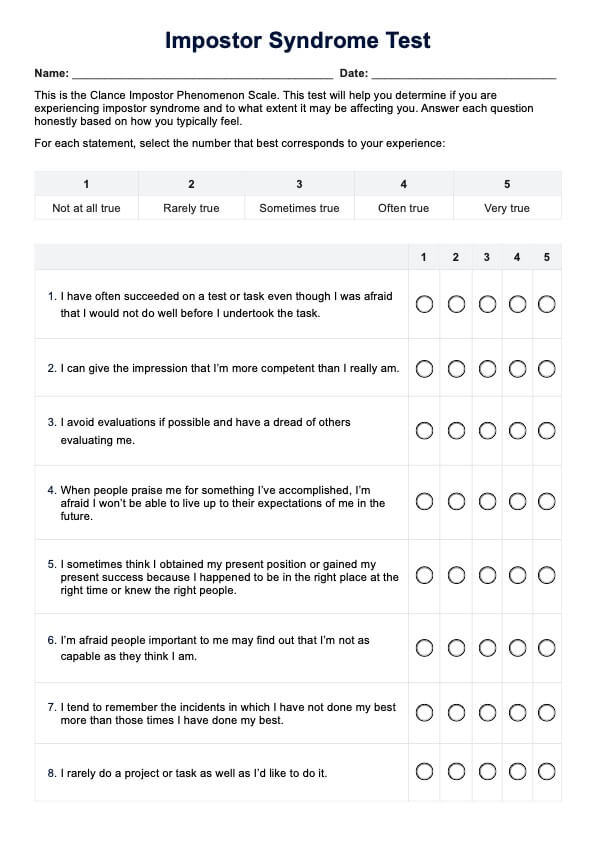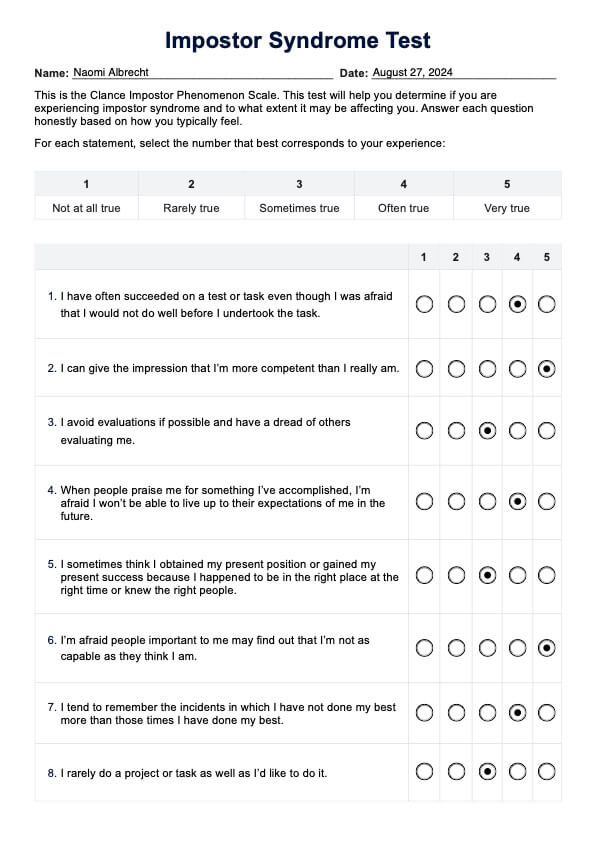Impostor Syndrome Test
Assess feelings of self-doubt with our Impostor Syndrome Test. Get practical insights, scoring, and guidance tailored for healthcare professionals.


What is an Impostor Syndrome Test?
An Impostor Syndrome Test is a psychological assessment tool designed to help individuals identify whether they experience feelings commonly associated with impostor syndrome. This psychological pattern is characterized by chronic self-doubt and feelings of inadequacy— a person with imposter syndrome feels a persistent fear of being exposed as a "fraud" despite evidence of success and competence.
The term "impostor phenomenon" was first coined by psychologists Dr. Pauline Clance and Dr. Suzanne Imes (Clance & Imes, 1978). Their work described how high-achieving individuals often attribute their accomplishments to luck or external factors rather than their abilities and hard work. These attributions can fuel feelings of inadequacy and self-doubt.
After their paper came a slew of other research across the years, which gave way to the development of the Impostor Syndrome Test. This typically includes a series of statements or questions that assess various aspects of an individual's thoughts, emotions, and behaviors. These may include:
- Self-doubt and insecurity: Questions might explore how frequently an individual feels unworthy of their accomplishments or doubts their capabilities.
- Attribution of success: The test may ask whether individuals believe their success is due to external factors like luck or timing rather than their skills and effort.
- Fear of exposure: It might assess how often someone fears that others will discover they are not as competent as they appear to be.
- Perfectionism: The test could evaluate tendencies toward perfectionism and how it relates to feelings of inadequacy.
- Comparisons to others: It may ask about the extent to which individuals compare themselves to their peers and how these comparisons affect their self-esteem.
- Emotional responses: The test might gauge emotional reactions to success, such as anxiety, guilt, or fear, which are common among those with impostor syndrome.
While an Impostor Syndrome Test can offer valuable insights, it is important to note that it is not a diagnostic tool. Instead, it is a self-assessment that can help individuals recognize patterns in their thoughts and feelings.
Impostor Syndrome Test Template
Impostor Syndrome Test Example
How to use our Impostor Syndrome Test template
While there is no evidence-based Healthcare professionals can use our imposter syndrome quiz as a tool to assess and understand the extent to which their clients or patients may be experiencing impostor syndrome. Follow these steps to effectively implement the template in your practice.
Step 1: Access the template
First, access the template by clicking the "Use template," which will open it in the app. From there, you can customize it, print it, or share it. You can save a fillable and printable copy to your device by clicking "Download" or looking for it on the Resouce Library in our website.
Step 2: Introduce the Likert scale
Begin by explaining to your clients or patients how to respond to the test's items. Clarify that each statement in the test is rated on a scale from 1 to 5, where 1 means "Not at all true" and 5 means "Very true." The total score will indicate the severity of impostor syndrome symptoms.
Step 3: Guide honest responses
Encourage clients or patients to answer each question honestly based on their typical feelings and experiences. Emphasize the importance of reflecting on their true thoughts to ensure an accurate assessment.
Step 4: Calculate the total score
After all the quiz questions have been answered, add up the responses to calculate the total score. This score will help you gauge the level of impostor syndrome the client or patient may be experiencing.
Step 5: Provide guidance based on the results
Depending on the score, discuss the implications of impostor syndrome with the client or patient. For those with moderate to intense scores, consider recommending further psychological support or therapeutic interventions to address the challenges associated with impostor syndrome.
Step 6: Review and follow-up
Finally, schedule follow-up sessions to monitor progress and reassess the client or patient's experiences over time. Adjust treatment plans as needed based on changes in the person or their impostor syndrome symptoms.
Scoring
The Impostor Syndrome Test provides a total score based on responses to the 20 statements, with each response rated on a scale from 1 to 5. After calculating the total score, it can be classified into one of four categories:
- 40 or less: Indicates few or no impostor syndrome characteristics.
- 41-60: Suggests moderate experiences of impostor syndrome, where feelings of self-doubt may occasionally arise.
- 61-80: Reflects frequent impostor syndrome feelings, where self-doubt is a significant concern.
- 81+: Points to intense and persistent impostor syndrome experiences, which may require professional intervention.
This scoring system helps healthcare professionals identify the severity of impostor syndrome in their clients or patients, allowing for tailored interventions and support.
Next steps after conducting/taking this test
After completing the Impostor Syndrome Test, healthcare professionals should thoroughly review the results with their clients or patients. This discussion should focus on understanding the implications of their score and how impostor syndrome may be affecting various aspects of their lives, such as work, job performance, relationships, and overall mental well-being.
For those who score in the moderate to intense range, it’s important to explore further interventions. Cognitive-behavioral therapy (CBT) is often recommended to help individuals challenge and reframe their negative thought patterns. Encourage clients to give positive feedback, develop self-compassion, and recognize their achievements by keeping a success journal or practicing mindfulness techniques. These strategies can be particularly effective in reducing the impact of impostor syndrome.
In cases where impostor syndrome is significantly interfering with a client’s daily life, consider referring them to a mental health professional specializing in this area. Group therapy or support groups may also be beneficial, as they tend to allow individuals to share their experiences and realize they are not alone in their feelings of self-doubt.
Additionally, it’s crucial to schedule regular follow-up sessions to monitor progress and make any necessary adjustments to the treatment plan. This ongoing support helps ensure that the client is making strides in overcoming impostor syndrome and can maintain their mental well-being over time. Provide resources such as books, articles, or online courses that focus on building confidence and resilience, further empowering your clients to manage and reduce the effects of impostor syndrome.
Reference
Clance, P. R., & Imes, S. A. (1978). The imposter phenomenon in high achieving women: Dynamics and therapeutic intervention. Psychotherapy: Theory, Research & Practice, 15(3), 241–247. https://doi.org/10.1037/h0086006
Commonly asked questions
Imposter syndrome most commonly affects high-achieving individuals, often women, particularly those in demanding or competitive fields, such as academics, professionals, and creatives. It is also often felt by people starting a new job.
Remind them that their feelings of self-doubt are common among high achievers and encourage them to recognize and celebrate their successes.
Manage imposter syndrome by practicing self-compassion, seeking support from mentors or peers, and reframing negative thoughts into positive affirmations.




















-template.jpg)



















































































